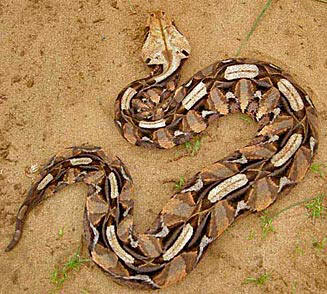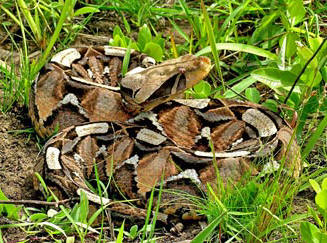|
Bitis gabonica (Gaboon adder, Central African Gaboon adder)
Koning-Poffadder, Gaboenadder [Afrikaans]
Life >
Eukaryotes
>
Opisthokonta >
Metazoa
(animals) > Bilateria > Deuterostomia >
Chordata >
Craniata > Vertebrata (vertebrates) > Gnathostomata (jawed vertebrates) >
Teleostomi (teleost fish) > Osteichthyes (bony fish) > Class:
Sarcopterygii (lobe-finned fish) > Stegocephalia (terrestrial vertebrates) >
Tetrapoda
(four-legged vertebrates) > Reptiliomorpha > Amniota >
Reptilia (reptiles) >
Romeriida > Diapsida > Lepidosauromorpha > Lepidosauria >
Squamata > Serpentes
(snakes) > Family: Viperidae > Genus:
Bitis
 |
 Bitis gabonica (Gaboon adder, Central African Gaboon adder), KwaZulu-Natal [T Phelps
©, from
SARCA
Virtual Museum] |
|
Bitis gabonica (Gaboon adder, Central African Gaboon adder),
KwaZulu-Natal [J.K Warner ©,
from
SARCA
Virtual Museum] |
|
Identification
It can be easily identified by its distinctive large pale
coloured head, its uniquely coloured body and its large size. Has an
average length of 90 cm but may reach 1.2 meters.
Distribution and habitat
Has a confined distribution in Southern
Africa, only being found in Northern KwaZulu-Natal and on the border of Zimbabwe and
Mozambique. Its preferred habitat is lowland forest.
Food
Feeds on
rodents (e.g.
rats and mice),
hares,
doves,
monkeys and small
antelope.
Predators, parasites and disease
Has few if any natural predators (It is
able to kill potential predators such as
mongooses), It is however threatened by
habitat destruction.
Reproduction
Viviparous (give birth to live young); mating takes place between March and May; the young
are born approximately a year later.
Longevity
Has been known to live for up to 20 years,
however they usually live between 12 and 15 years.
Medical importance
Has a very powerful cytotoxic venom, which it
injects in large amounts through its fangs. Its fangs are the longest of any
poisonous snake in the world. Its bite is a medical emergency and requires
urgent treatment in order to save the limb that has been bitten, and a large amount of antivenom
is required to counter the effects of the venom. Despite this
there are few recorded bites, mostly because this snake is rare and is not aggressive.
Links
References
-
Broadley, D.G. 1983. FitzSimons' Snakes of Southern
Africa. Delta Books, Johannesburg.
-
Marais, J. 2004. A Complete Guide to Snakes of
Southern Africa. Struik Publishing, Cape Town.
|
